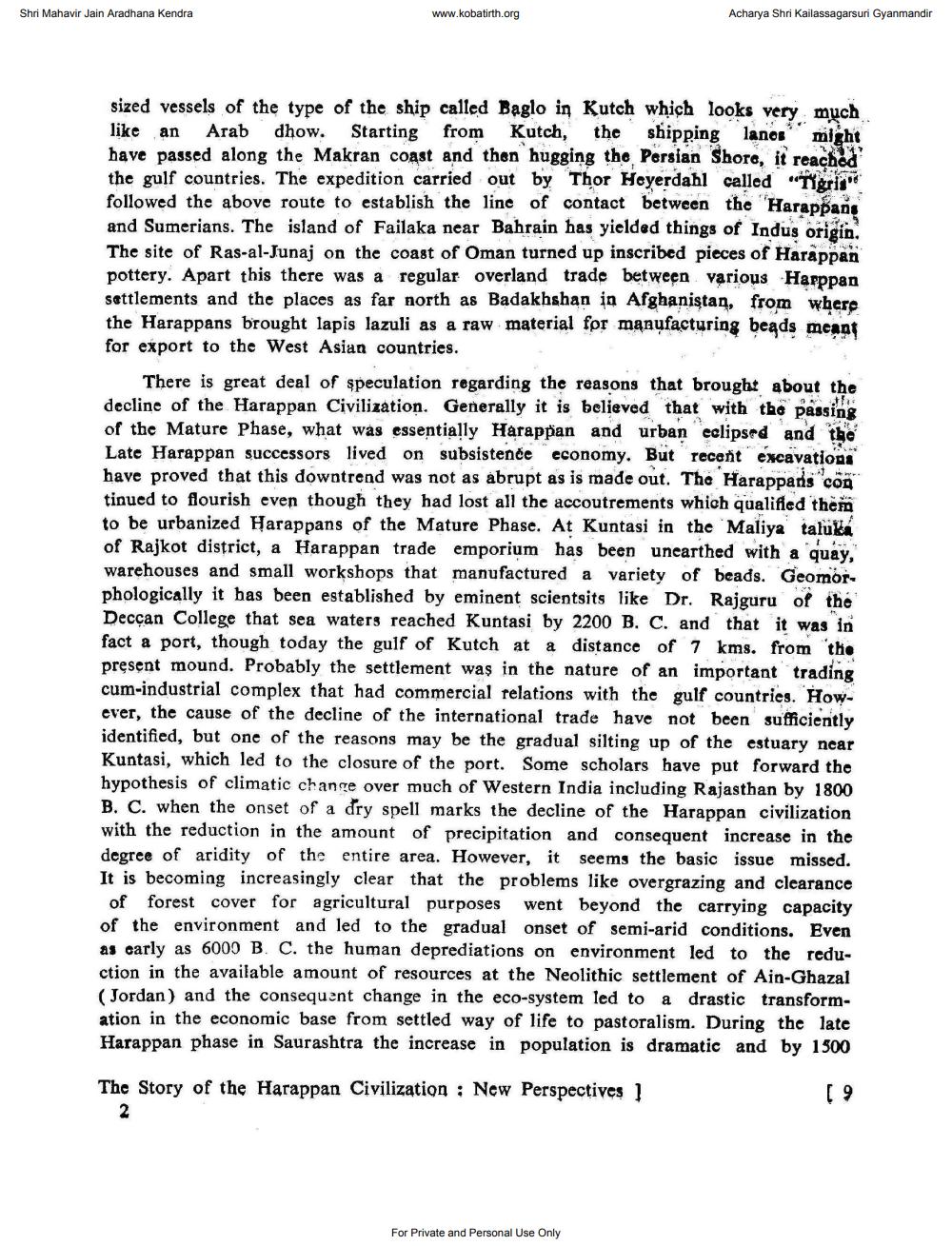________________
Shri Mahavir Jain Aradhana Kendra
www.kobatirth.org
Acharya Shri Kailassagarsuri Gyanmandir
sized vessels of the type of the ship called Baglo in Kutch which looks very much like an Arab dhow. Starting from Kutch, the shipping lanos might have passed along the Makran coast and then hugging the Persian Shore, it reached the gulf countries. The expedition carried out by Thor Heyerdahl called "Tygrip followed the above route to establish the line of contact between the 'Harapbans and Sumerians. The island of Failaka near Bahrain has yielded things of Indus origin. The site of Ras-al-Junaj on the coast of Oman turned up inscribed pieces of Harappan pottery. Apart this there was a regular overland trade between various Harppan settlements and the places as far north as Badakhshan in Afghanistan, from where the Harappans brought lapis lazuli as a raw material for manufacturing beads meant for export to the West Asian countries.
There is great deal of speculation regarding the reasons that brought about the decline of the Harappan Civilization. Generally it is believed that with the passing of the Mature Phase, what was essentially Harappan and urban eclipsed and the Late Harappan successors lived on subsistence economy. But recent excavations have proved that this downtrend was not as abrupt as is made out. The Harappans con tinued to flourish even though they had lost all the accoutrements which qualified them to be urbanized Harappans of the Mature Phase. At Kuntasi in the Maliya taluka of Rajkot district, a Harappan trade emporium has been unearthed with a quay, warehouses and small workshops that manufactured a variety of beads. Geomorphologically it has been established by eminent scientsits like Dr. Rajguru of the Deccan College that sea waters reached Kuntasi by 2200 B. C. and that it was in fact a port, though today the gulf of Kutch at a distance of 7 kms. from the present mound. Probably the settlement was in the nature of an important trading cum-industrial complex that had commercial relations with the gulf countries. However, the cause of the decline of the international trade have not been sufficiently identified, but one of the reasons may be the gradual silting up of the estuary near Kuntasi, which led to the closure of the port. Some scholars have put forward the hypothesis of climatic change over much of Western India including Rajasthan by 1800 B. C. when the onset of a dry spell marks the decline of the Harappan civilization with the reduction in the amount of precipitation and consequent increase in the degree of aridity of the entire area. However, it seems the basic issue missed. It is becoming increasingly clear that the problems like overgrazing and clearance
of forest cover for agricultural purposes went beyond the carrying capacity of the environment and led to the gradual onset of semi-arid conditions. Even as carly as 6000 B. C. the human deprediations on environment led to the reduction in the available amount of resources at the Neolithic settlement of Ain-Ghazal (Jordan) and the consequent change in the eco-system led to a drastic transformation in the economic base from settled way of life to pastoralism. During the late Harappan phase in Saurashtra the increase in population is dramatic and by 1500
The Story of the Harappan Civilization : New Perspectives ]
( 9
For Private and Personal Use Only




